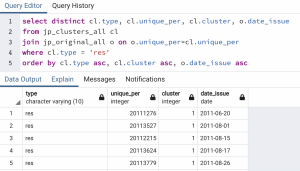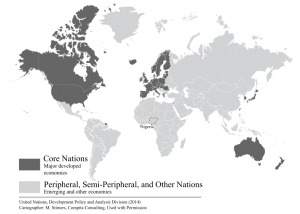
Are you planning on including quantitative analysis in your thesis or dissertation, but aren’t sure where to start? CEO Dr. Mitch Stimers and Associate Consultant Sisira Lenagala are experts in statistical analysis, including spatial analysis. We can help you at any stage of the process, from determining what tests to use, collecting and cleaning data, designing and querying a custom PostgreSQL database, and completing the analysis portion.
If your thesis statement has led you to an analytical approach to your research questions, we’ll help you design and execute that section. You can also call on us to help you through interpretation, or maybe just run some simple statistics. There are dozens of possibilities when it comes to statistical analysis, so we won’t list them all, but here are some of the more common, and a few of the more complex, methods that we can execute for you.
Statistics Services
Exploratory Data Analysis (EDA): Tests for Normality (e.g., Kolmogorov-Smirnov, Shapiro-Wilks, (Kurtosis/SE)>2, (Skewness/SE)>2), Histograms, Q-Q Plots, Log-Log Plots, Mean/Median/Mode/Standard Deviation/Variance/Standard Error
G*Power Analysis or Cochran's formula: Ensure you choose the proper sample size for your statistical tests, including chi-square, exact, t-tests, F-tests, and z-tests.
Difference of Means (t, z, Wilcoxon): One of the most commonly used types of tests; determines if a significant difference exists between the mean of two groups.
Tukey's Range Test (aka Tukey's Honestly Significant Difference, or Tukey's HSD): Multiple comparison modeling (pairwise) in which the means of a group are compared to all other means of groups in the model (similar to a t-test, with an extra correction component for standard error).
ANOVA (Analysis of Variance): Also a difference-of-means test, but for multiple columns. A very popular method in the social sciences, ANOVA will hold up well to violations of pre-test assumptions such as equal variance or a normal distribution of your data (a shortcoming of other difference-of-means tests, such as a t-test or Tukey's HSD).
Chi-square: Another very commonly used test; determines if a set of observations occurs more frequently or less frequently than expected.
Correlation (Pearson's r, Spearman's rho, Kendall's T): The one almost everyone has at least heard of. Correlation analysis determines if two variables exhibit a linear relationship; as one goes up, does the other follow along (up or down) at some level of statistical significance? While correlation cannot tell you the cause, it can tell you quickly if your two phenomena are related in some way.
Regression (Binary, Multivariate): Widely-used, and relatively straight-forward, this method works to uncover the influence a group of variables (the independents) has on a single variable (the dependent).
Composite Index Construction: Using weights derived from analysis (e.g., PCA, MCDA), virtually any continuous, interval, or ratio data set can be transformed into a composite scaled and ranked index, which can greatly enhance the statistical section of your thesis. We can essentially construct a highly customized rating system for some quantitative component of your results.
Dimensionality (data) Reduction: Principal Components Analysis (PCA) and Linear or General Discriminant Analysis (LDA or GDA) are used to uncover relationships hidden within very large datasets, and reduce the data to groups of components or factors that help explain some assumption or relationship. These methods are very useful if you have a lot of data and are not sure how the pieces might be connected. As mentioned above, factors, components, and/or eigenvalues can be used in additional model building such as regression or generalized linear modeling.
Multi-Criteria Decision Analysis (MCDA) is a broad term for one of several methods to reduce complex decision-making processes to understandable results. The Analytic Hierarchy Process (AHP) is a powerful and flexible method of MCDA, using a process called expert elicitation to transform the qualitative opinions of experts into useable weights and measures.
For an example of PCA and composite index development, see Dr. Stimers’ 2011 Ph.D. work, pages 76-77, or this paper. For an example of MCDA/AHP, see this paper, co-authored by Dr. Stimers and Sisira Lenagala. Data analysis consultants work mainly in SPSS, Excel, R Studio, PostgreSQL, QuantumGIS/QGIS, and the ESRIArcGIS suite.
Custom Database Builds and Query Work
 Data can be used in many ways to accomplish your research goals. Aside from statistical testing, a large Excel sheet or two (called a “heap”) can be transformed into a working database that can be queried to deliver results you might struggle with using more conventional methods in Excel Our analysts have worked in both the public and private sector as data managers and database administrators. We can take your data, clean it, import it into a PostgresSQL database, then work with you to start querying the data. You may uncover deeper datasets that might lead you in new research directions or help you provide additional support to your conclusions. Querying data will likely produce results you can use to your advantage!
Data can be used in many ways to accomplish your research goals. Aside from statistical testing, a large Excel sheet or two (called a “heap”) can be transformed into a working database that can be queried to deliver results you might struggle with using more conventional methods in Excel Our analysts have worked in both the public and private sector as data managers and database administrators. We can take your data, clean it, import it into a PostgresSQL database, then work with you to start querying the data. You may uncover deeper datasets that might lead you in new research directions or help you provide additional support to your conclusions. Querying data will likely produce results you can use to your advantage!
Survey Design, Distribution, & Analysis for Thesis Work
Do you need a research survey for your research paper, thesis, dissertation? Our team has over 20 years of experience in designing surveys and will create an instrument to collect the data and information you are after. We’ve designed and executed surveys in the areas of customer opinion and market research, post-natural-disaster analysis, student retention studies, employee climate/pulse survey, and voting polling. All survey work includes helping you in writing the application to obtain IRB approval, needed to conduct research on human subjects if that is your focus. Once the survey closes, the full data set is yours to analyze, or, you can retain us to help you through the analysis stage as well.
Once the survey closes, the full data set is yours to analyze, or, you can retain us to help you through the analysis stage as well.
Geographic Information Systems Services
Our team includes two consultants with advanced degrees in geography (M.A., Ph.D.) and geoinformation sciences (M.S.). If you find that there is a spatial component to your thesis statement, let us help you produce a stronger and more robust document by examining that component! We can go from simple to involved, basic place/location mapping to advanced spatial statistics like geographically weighted regression (GWR), Moran’s I/LISA, Getis-Ord/Gi*, and Kriging.

If your collected data has an address component, such as street addresses or up to zip codes, we can perform a procedure called geocoding, in which your location data in a simple spreadsheet can be converted to latitude-longitude points and plotted on a map for further analysis. This is an example of around 15,000 street addresses of applicants to a college, geocoded, and plotted. The two ellipses are standard deviational ellipses, indicating one and two standard deviations from the geographic center of the cluster.
Or maybe you just want a simple but clean custom choropleth map? We can do that, too! 